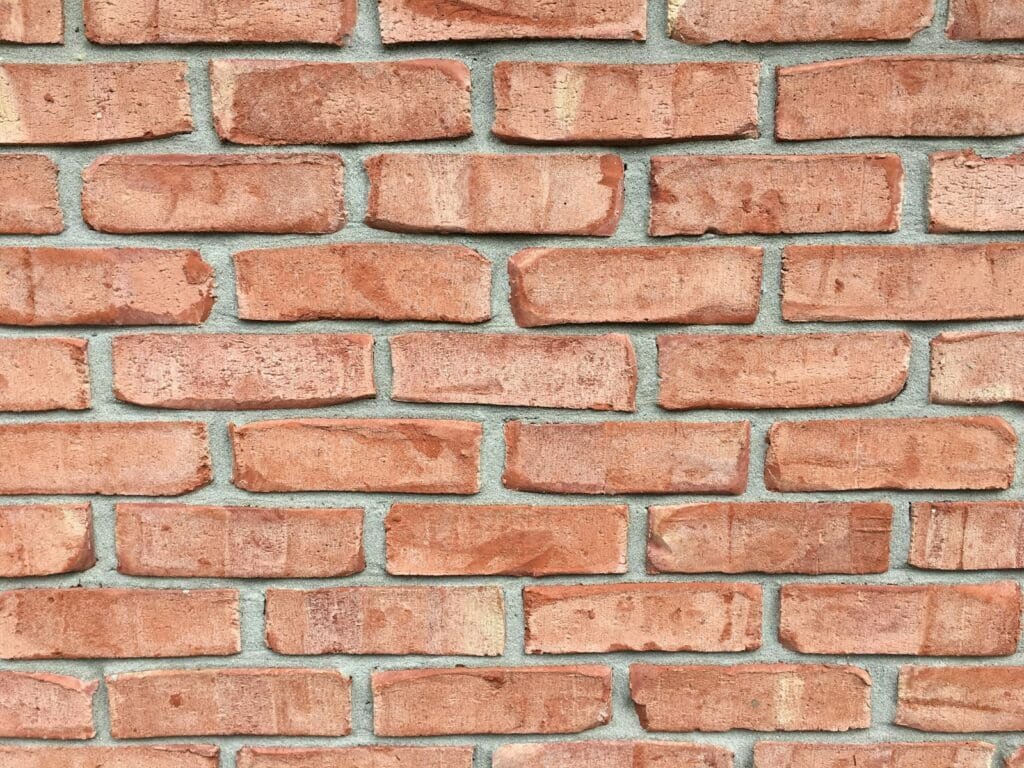Introduction
Do you ever look at a brick wall and wonder about the patterns you see?
Those patterns aren’t just for aesthetics – they’re carefully chosen bonds that play a pivotal role in the wall’s stability and durability.
In this article, we’ll look into several types of bricklaying bonds, including the Header, Stretcher, English, Flemish, Stack, and 5 Course Common bonds, outlining their definitions, key characteristics, applications, and comparison with each other.
We’ll also explore examples in practice, beneficial qualities, practical installation tips, and real-world examples of these bonds.
Whether you’re a construction professional or a curious homeowner, understanding these bonds will equip you with knowledge to appreciate brick constructions more deeply.
Table of Contents
Understanding Header Bonds in Construction

Definition of Header Bond
A header bond is a pattern in masonry where the headers (short ends of the bricks) are the visible face in the wall. It is used for the construction of walls when the thickness of the wall is equivalent to the length of one brick.
Key Characteristics
- Bricks are laid with their headers facing out.
- Commonly used for one-brick thick walls.
- Provides a highly stable and strong wall construction.
Applications
Header bonds are typically used in:
- Single-brick walls.
- Curved structures where a tighter bond is necessary.
- Decorative masonry for aesthetic purposes.
Comparison Table
| Bond Type | Visible Pattern | Common Thickness |
|---|---|---|
| Header Bond | Headers | One-brick thick |
| Stretcher Bond | Stretchers | Half-brick thick |
| English Bond | Alternate Stretcher and Header rows | Two-brick thick |
Example in Practice
One notable use of header bonds can be found in historic buildings where stability was key. For instance, many classic European structures feature header bonds to enhance the strength and provide an aesthetically pleasing appearance.
Installation Tips
To ensure a proper header bond in your masonry project:
- Align the bricks evenly for a uniform look.
- Ensure consistent mortar joints for stability.
- Regularly check for level and plumb with tools.
Examining Other Common Bricklaying Bonds

Stretcher Bond Pattern
Before we proceed, it’s important to note that the stretcher bond is the simplest bonding pattern in bricklaying. Instead of using the header (short end) of the brick, the stretcher (long side) is put on display. This design is commonly used for walls that are half a brick thick, making it a great choice for partition walls or veneering.
Characteristics and Application of Stretcher Bond
- Primarily defined by the stretchers facing outward.
- Ideal for walls of a half-brick thickness.
- Popularly used for partitions and decorative veneering.
Identifying the English Bond
The English bond, which alternates between courses of headers and stretchers, creates the thickest walls in the masonry industry, often two bricks thick. This bond’s thickness makes it ideal for load-bearing walls and other structures requiring high strength.
Features and Uses of the English Bond
- Recognisable by alternating rows of headers and stretchers.
- Used primarily in constructing two-brick thick walls.
- Applicable in load-bearing structures due to its superior strength.
Inspecting the Flemish Bond
The Flemish bond is considered a decorative yet strong bond. It alternates stretchers and headers within the same course, lending to a unique aesthetic appeal. This makes it frequently used in exterior walls of buildings where aesthetic appeal is as important as structural integrity.
Features and Utility of the Flemish Bond
- Visible pattern includes both headers and stretchers on the same course.
- Commonly used for one-brick thick walls.
- Utilized predominantly in outer walls due to its strength and appealing look.
Examining Stack Bond Pattern
In a Stack bond, bricks are stacked directly on top of one another, creating a straightforward, orderly look. While the aesthetic appeal of this bond is high, it doesn’t offer the same level of structural stability as other bonds, thus often used in combination with reinforcement or in non-load bearing walls.
Characteristics and Applications of Stack Bond
- Includes vertically stacked bricks aligned directly above one another.
- Generally used for non-load bearing walls or where reinforcement is used.
- Highly chosen for its modern, clean lines and orderly appearance.
What is a 5 Course Common Bond?
Overview of the 5 Course Common Bond
The 5 course common bond is a specific masonry bond pattern that incorporates both headers and stretchers. The pattern is established by using one row of headers for every five rows of stretchers. This pattern increases the wall’s stability and is frequently used in construction for both aesthetic and structural benefits.
Defining Characteristics
- One row of headers after every five rows of stretchers.
- Enhanced wall stability and load-bearing capacity.
- Visible alternating pattern every few rows.
- Often used in both modern and historic buildings.
Structural Benefits of the 5 Course Common Bond
The 5 course common bond enhances the wall’s overall durability and strength. Here are a few key benefits:
- Strength: Alternating rows provide additional lateral support.
- Stability: The regular insertion of header rows helps bind the stretchers together more effectively.
- Durability: This pattern helps in evenly distributing the load, reducing the risk of cracks.
Comparison Table with Other Bonds
| Bond Type | Visible Pattern | Common Thickness |
|---|---|---|
| 5 Course Common Bond | 1 Header Row after 5 Stretcher Rows | Varies |
| Header Bond | Headers | One-brick thick |
| Stretcher Bond | Stretchers | Half-brick thick |
| English Bond | Alternate Stretcher and Header rows | Two-brick thick |
| Flemish Bond | Alternate Stretchers and Headers in the same row | One-brick thick |
| Stack Bond | Vertically aligned | Varies |
Real-World Examples and Uses
The 5 course common bond is prevalent in various structures due to its balance of aesthetic and functional benefits. You might find it in:
- Historical monuments that require robust construction.
- Modern buildings seeking a mix of classic and contemporary looks.
- Residential homes where structural integrity is prioritized along with design.
Installation Tips for the 5 Course Common Bond
To achieve a proper and effective 5 course common bond in your masonry project, consider these tips:
- Plan Ahead: Layout your bricks and calculate the number of stretchers and headers needed.
- Consistency: Maintain uniform mortar joints and check regularly for level and plumb.
- Strength: Ensure the header rows interlock well with the adjacent stretcher rows for optimal strength.
Further Reading
For more information on building techniques, check out this comprehensive guide on classic masonry principles.
Understanding Common Bond and English Bond in Construction
Common Bond Patterns
Common bond, also referred to as “running bond” or “stretching bond,” is one of the most traditional and widely used bricklaying patterns. It is characterized by the consistent alignment of stretcher courses, where each brick is laid with its longest face visible. This pattern is frequently employed in the construction of half-brick thick walls, such as building veneers and partition walls.
Features of Common Bond
- Bricks are laid horizontally with the stretcher facing outward.
- Suitable for half-brick thick walls.
- Provides a relatively lightweight and visually appealing wall.
Uses of Common Bond
Common bond is particularly suited to:
- Residential housing facades.
- Yard and garden walls.
- Partition walls in homes and commercial buildings.
English Bond Pattern
English bond is a traditional and highly robust bricklaying pattern, recognized by its distinct alternation between rows (courses) of headers and rows of stretchers. This layout provides the highest level of engineering strength, making it ideal for load-bearing and structurally demanding walls. English bond typically results in two-brick thick walls, providing enhanced durability and stability.
Features of English Bond
- Alternating rows of headers (brick ends) and stretchers (long sides).
- Ideal for two-brick thick walls.
- Offers exceptional structural strength and load-bearing capacity.
Uses of English Bond
Some common applications for English bond include:
- Foundation walls.
- Load-bearing walls in both residential and commercial buildings.
- Historic and restoration projects where strength and authenticity are needed.
Comparative Analysis
Comparison Table of Bond Types
Here’s a comparative analysis between the common bond and English bond, showcasing their key characteristics and applications.
| Bond Type | Visible Pattern | Common Thickness | Applications |
|---|---|---|---|
| Common Bond | Stretchers | Half-brick thick | Partition walls, facades, residential housing |
| English Bond | Alternate Stretcher and Header rows | Two-brick thick | Load-bearing walls, foundations, historic buildings |
Additional Bonds Used in Masonry
Characteristics of Flemish Bond
The Flemish bond combines both stretcher and header bricks within the same course. This pattern offers an attractive appearance while still maintaining structural strength.
- Features headers and stretchers in each row.
- Commonly used for one-brick thick walls.
- Favoured in decorative and exterior applications.
Advantages of Stack Bond
Stack bond features bricks stacked directly over one another with no overlap. While it offers a clean and modern aesthetic, it lacks the structural interlocking that provides additional strength in other patterns.
- Vertically aligned bricks.
- Best suited for non-load bearing walls.
- Often used with reinforcements for added stability.
Practical Installation Tips for Various Bonds
For Common Bond
- Ensure even alignment of stretchers.
- Use consistent mortar joints.
- Regularly check for level and uniformity.
For English Bond
- Alternate between header and stretcher rows meticulously.
- Double-check the alignment to maintain structural integrity.
- Reinforce with additional mortar if necessary to increase load-bearing capacity.
For Flemish Bond
- Plan for an even distribution of headers and stretchers within each course.
- Ensure consistent spacing and quality of mortar joints.
- Verify the wall’s leveling frequently to maintain appearance and stability.
Conclusion: The Mastery of Masonry Bonds
In the world of masonry construction, the pattern in which bricks are laid, also known as the bond, can make a significant difference in the structural stability and aesthetic appeal of a wall.
The Header Bond is ideal for one-brick-thick walls giving strong and stable wall formation, while the Stretcher, Flemish, and Stack bond offer varying visual impacts and utility.
The 5 Course Common Bond is a hybrid approach, using both headers and stretchers for enhanced stability in various construction projects, and the English bond is best for heavy-duty, load-bearing walls.
Lastly, the Common Bond, often used for half-brick thick walls, is a classic pattern that blends well with a wide range of architectural styles.
Frequently Asked Questions – FAQs
What is a header bond in masonry?
The header bond is a pattern in masonry where the headers (the short ends of the bricks) are the visible face in the wall. It is typically used for the construction of walls when the thickness of the wall is equivalent to the length of one brick.
What are the key characteristics of a stretcher bond?
Stretcher bonds are primarily defined by the stretchers (long sides of the bricks) facing outward. They are ideal for walls of half-brick thickness and are popularly used for partitions and decorative veneering.
How is an English bond pattern identified?
An English bond pattern is recognised by the alternating rows of headers and stretchers. This type of bond is used primarily in constructing two-brick thick walls and is applicable in load-bearing structures due to its superior strength.
What are the structural benefits of a 5 Course Common Bond?
The 5 Course Common Bond enhances the wall’s overall durability and strength. It provides additional lateral support, binds the stretchers together more effectively, and helps in evenly distributing the load, thus reducing the risk of cracks.
What is the main difference between Common Bond and English Bond?
The Common Bond utilizes stretchers, is suitable for half-brick thick walls and is often used in partition walls and facades. The English Bond, on the other hand, alternates between rows of headers and stretchers, ideal for two-brick thick walls, and is used in load-bearing walls, foundations, and historic buildings.






